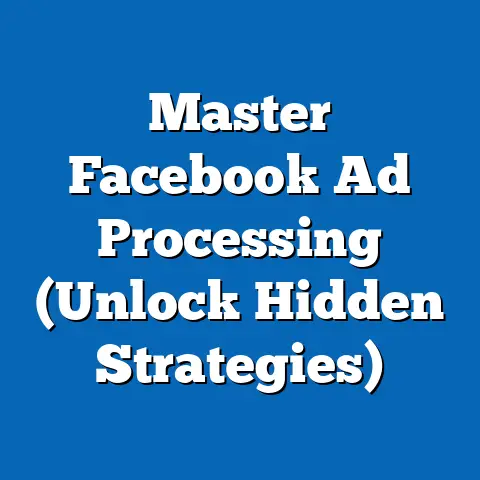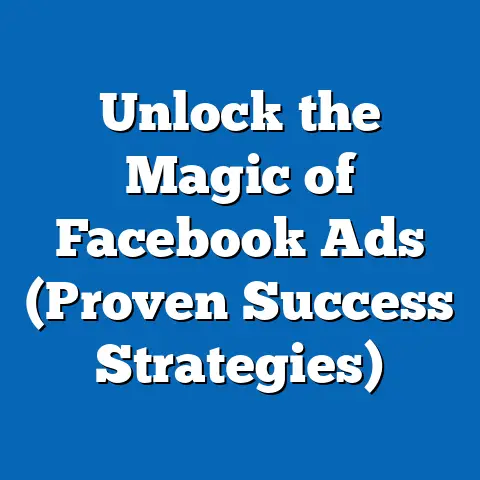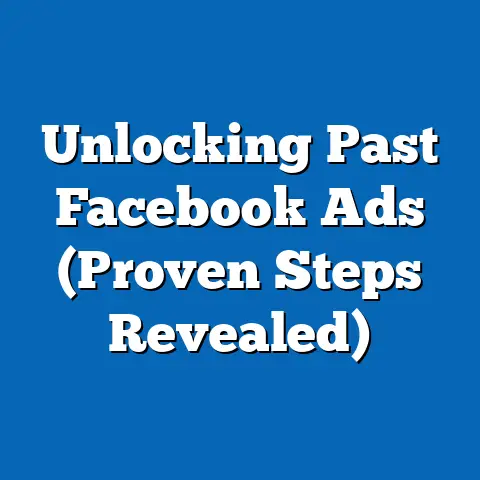Master Facebook Ad Test (Proven Strategies Revealed)
Craftsmanship, at its core, represents the pursuit of excellence through skill, dedication, and attention to detail in creating or refining a product, service, or process. Historically associated with artisans and tradespeople who honed their skills over years of practice, craftsmanship embodies qualities such as precision, creativity, and a deep understanding of materials or tools. In the modern context, this concept extends beyond physical goods to include digital domains, where mastery of platforms, algorithms, and user behavior is paramount.
In the realm of digital marketing, craftsmanship manifests in the ability to design, test, and optimize campaigns with meticulous care. This article explores how the principles of craftsmanship apply to mastering Facebook ad testing—a critical skill for marketers aiming to maximize return on investment (ROI) in an increasingly competitive landscape. By delving into historical parallels, key strategies, and societal implications, we uncover how digital craftsmanship shapes modern advertising.
This analysis will bridge the traditional ethos of craftsmanship with the cutting-edge demands of Facebook advertising, offering proven strategies backed by data and expert insights. We will examine the evolution of ad testing, the defining characteristics of effective strategies, and the broader impact on businesses and consumers. Ultimately, this article aims to equip readers with actionable insights while fostering an appreciation for the artistry behind digital marketing.
Craftsmanship: Defining Characteristics and Historical Context
Craftsmanship has long been a hallmark of human achievement, dating back to ancient civilizations where skilled artisans crafted tools, pottery, and architecture with remarkable precision. From the intricate metalwork of the Renaissance to the disciplined apprenticeships of medieval guilds, craftsmanship has historically been tied to mastery over one’s trade, often requiring years of learning under a mentor. Key characteristics include a commitment to quality over quantity, an iterative approach to improvement, and an intimate understanding of the materials or systems at play.
In societal terms, craftsmanship has often been a driver of economic and cultural progress. Skilled craftspeople contributed to the growth of trade, the preservation of cultural heritage, and the advancement of technology through innovation. For instance, the Industrial Revolution marked a turning point where craftsmanship adapted to mass production, balancing efficiency with quality—a tension that persists in today’s digital economy.
The societal implications of craftsmanship are profound, as it fosters trust between creators and consumers. A well-crafted product or service signals reliability, authenticity, and value, shaping consumer expectations and brand loyalty. In the digital age, this trust translates to how marketers craft campaigns that resonate authentically with audiences, much like how a carpenter tailors a piece of furniture to a client’s needs.
Craftsmanship in Digital Marketing: The Art of Facebook Ad Testing
As craftsmanship evolved with technological advancements, so too did the tools and mediums through which it is expressed. In digital marketing, platforms like Facebook have become the “workshop” where marketers refine their craft. With over 2.9 billion monthly active users as of 2023 (Statista, 2023), Facebook remains a dominant force in advertising, offering unparalleled reach and targeting capabilities.
Facebook ad testing—the process of experimenting with different ad creatives, audiences, placements, and messaging to optimize performance—embodies digital craftsmanship. Much like a sculptor chisels away at stone to reveal a masterpiece, marketers iterate on campaigns to uncover what drives clicks, conversions, and engagement. This process requires precision, patience, and a willingness to learn from failure, mirroring the iterative nature of traditional crafts.
However, the stakes in digital advertising are uniquely high due to the rapid pace of change and the vast data at play. A single ad campaign can generate thousands of data points within hours, demanding that marketers possess both analytical rigor and creative intuition. This duality of art and science defines the modern craft of ad testing, setting it apart from earlier forms of marketing where feedback loops were slower and less measurable.
Historical Context of Advertising and the Rise of Digital Testing
To fully appreciate the craftsmanship of Facebook ad testing, it’s essential to understand the broader evolution of advertising. In the early 20th century, print and radio ads relied on broad messaging with limited ability to measure impact beyond anecdotal feedback or sales figures. The advent of television in the mid-20th century introduced visual storytelling, but testing remained rudimentary, often involving focus groups or regional rollouts.
The internet revolutionized advertising in the late 1990s and early 2000s, introducing real-time analytics and the ability to target specific demographics. Google’s AdWords (launched in 2000) pioneered pay-per-click models, while social media platforms like Facebook (which introduced ads in 2007) brought unprecedented granularity to audience targeting. These innovations shifted advertising from a “spray and pray” approach to a data-driven craft where every element of a campaign could be tested and optimized.
Defining Characteristics of Masterful Facebook Ad Testing
Mastering Facebook ad testing requires a blend of strategic planning, technical proficiency, and creative problem-solving. Below are the key characteristics that define this craft, each reflecting the meticulous attention to detail inherent in traditional craftsmanship.
1. Iterative Experimentation
Much like a potter shapes clay through repeated adjustments, successful ad testing relies on continuous experimentation. Marketers must test variables such as headlines, images, call-to-action (CTA) buttons, and audience segments to identify what resonates. This iterative process often involves A/B testing or multivariate testing, where small changes are measured for statistically significant impact.
2. Data-Driven Decision Making
Craftsmanship in ad testing hinges on interpreting data with precision. Tools like Facebook Ads Manager provide metrics such as click-through rates (CTR), cost per acquisition (CPA), and return on ad spend (ROAS), enabling marketers to make informed decisions. A study by WordStream (2022) found that businesses that regularly test and optimize ads achieve up to 30% lower CPAs compared to those that don’t.
3. Audience Empathy
Understanding the target audience is akin to a tailor measuring a client for a bespoke suit. Effective ad testing requires empathy—knowing the pain points, desires, and behaviors of different segments. This ensures that campaigns are not only data-driven but also emotionally resonant, a balance that separates good ads from great ones.
4. Adaptability to Platform Changes
Facebook’s algorithm and policies evolve frequently, much like how changing seasons affect a farmer’s craft. Marketers must stay abreast of updates—such as the iOS 14.5 tracking restrictions introduced in 2021—that impact ad performance. Adaptability ensures that testing strategies remain relevant amidst shifting digital landscapes.
5. Creative Innovation
While data is critical, creativity remains the heart of ad testing. Crafting compelling visuals, copy, and offers requires an artistic sensibility that can’t be fully automated. The best marketers blend analytical insights with bold ideas, much like how a jeweler combines technical skill with aesthetic vision.
Proven Strategies for Mastering Facebook Ad Testing
Having established the characteristics of digital craftsmanship, let’s explore proven strategies for mastering Facebook ad testing. These approaches, grounded in research and industry best practices, offer a blueprint for optimizing campaigns while embracing the iterative nature of the craft.
Strategy 1: Start with a Clear Hypothesis
Before launching any test, define a specific hypothesis based on existing data or insights. For example, “Will a video ad outperform a static image for a 25-34-year-old demographic interested in fitness?” This approach, recommended by digital marketing expert Neil Patel, ensures that tests are purposeful rather than random. A clear hypothesis provides a framework for interpreting results and iterating effectively.
Strategy 2: Test One Variable at a Time (A/B Testing)
To isolate the impact of specific elements, focus on testing one variable per campaign—whether it’s the headline, image, or audience. According to a 2021 study by HubSpot, A/B testing can improve conversion rates by up to 20% when done systematically. This methodical approach mirrors a scientist’s controlled experiments, ensuring clarity in understanding cause and effect.
Strategy 3: Leverage Dynamic Creative Optimization (DCO)
Facebook’s Dynamic Creative tool allows marketers to test multiple combinations of headlines, images, and CTAs within a single ad set. The platform automatically optimizes for the best-performing combination, reducing manual effort. A case study by Facebook (2022) showed that brands using DCO saw a 34% increase in conversions compared to static ads, highlighting the power of automation in scaling craftsmanship.
Strategy 4: Segment Audiences with Precision
Testing across broad audiences can dilute results, so segmenting based on demographics, interests, or behaviors is crucial. For instance, a clothing brand might test ads separately for urban millennials and rural Gen X consumers. This granular approach, supported by Facebook’s detailed targeting options, ensures that insights are actionable and relevant to specific groups.
Strategy 5: Monitor and Scale Gradually
Once a winning ad is identified, resist the urge to scale budgets aggressively. Gradual scaling—such as increasing spend by 20% daily—helps maintain performance stability, as sudden changes can disrupt Facebook’s algorithm. Digital marketing agency AdEspresso (2023) notes that gradual scaling preserves ad relevance scores, a key metric for cost efficiency.
Strategy 6: Analyze Beyond Surface Metrics
While CTR and CPA are important, deeper metrics like customer lifetime value (CLV) and ad fatigue (frequency) provide a fuller picture of performance. For example, an ad with a high CTR but low CLV may not be sustainable long-term. This holistic analysis reflects the craftsman’s ability to look beyond the obvious, ensuring long-term success.
Technological, Economic, and Social Factors Influencing Ad Testing
The craft of Facebook ad testing is shaped by a complex interplay of technological, economic, and social factors, each presenting opportunities and challenges for marketers.
Technological Factors
Advancements in machine learning and artificial intelligence have transformed how ads are tested and optimized. Facebook’s algorithm prioritizes user engagement, meaning ads must be tested not just for immediate results but for alignment with platform incentives. Additionally, privacy changes like Apple’s App Tracking Transparency (ATT) have reduced data availability, forcing marketers to rely on first-party data and contextual targeting—requiring a shift in testing methodologies.
Economic Factors
The cost of advertising on Facebook has risen steadily, with average CPM (cost per thousand impressions) increasing by 15% year-over-year in 2022 (WordStream, 2023). Economic pressures, such as inflation and consumer spending fluctuations, also influence ad performance, as audiences become more selective. Marketers must test cost-efficient strategies to maintain ROI, balancing creativity with budget constraints.
Social and Cultural Factors
Cultural trends and social movements shape how audiences respond to ads, necessitating culturally sensitive testing. For instance, campaigns tested during global events like the COVID-19 pandemic had to pivot to messaging around empathy and community support. Additionally, generational differences—such as Gen Z’s preference for authenticity over polished ads—require tailored testing approaches to resonate with diverse cohorts.
Comparing Generational Responses to Facebook Ads
While avoiding stereotypes, it’s useful to compare how different generations interact with Facebook ads, as this informs testing strategies. Baby Boomers (born 1946-1964), often less tech-savvy, may respond better to straightforward messaging and clear CTAs, with data showing they engage more with ads for health and financial products (Pew Research, 2022). Millennials (born 1981-1996), by contrast, value social proof and user-generated content, often requiring ads to feel personal and relatable.
Gen Z (born 1997-2012), the most digitally native cohort, prioritizes authenticity and visual storytelling, with platforms like TikTok influencing their expectations even on Facebook. Testing for Gen Z often involves short, snackable content and influencer-driven campaigns. These differences highlight the need for nuanced testing that accounts for generational diversity rather than assuming uniform behavior.
Societal and Workplace Implications of Ad Testing Craftsmanship
The mastery of Facebook ad testing extends beyond individual campaigns to broader societal and workplace impacts. On a societal level, well-crafted ads can drive economic growth by connecting businesses with consumers, but poorly tested or misleading ads risk eroding trust. The rise of “dark patterns” in digital advertising—manipulative tactics to drive clicks—has sparked ethical debates, emphasizing the need for responsible craftsmanship.
In the workplace, the demand for skilled ad testers has reshaped marketing roles, with companies increasingly seeking professionals who combine creativity with data literacy. According to LinkedIn’s 2023 Jobs Report, digital marketing specialists with testing expertise are among the fastest-growing roles, reflecting the premium placed on this craft. However, the pressure to deliver results quickly can lead to burnout, underscoring the need for sustainable practices in digital craftsmanship.
Nuances and Diversity Within Ad Testing Approaches
Just as traditional craftsmanship varies by culture and context, ad testing is not a one-size-fits-all endeavor. Small businesses with limited budgets may prioritize low-cost testing methods, such as split-testing basic creatives, while large corporations leverage advanced tools like AI-driven predictive analytics. Industry differences also play a role—e-commerce brands may focus on conversion-focused testing, while non-profits emphasize emotional storytelling.
Moreover, cultural nuances influence how ads are tested and received. A campaign tested in the U.S. may not resonate in Asia-Pacific markets due to differing values or humor styles, requiring localized testing. Acknowledging this diversity ensures that ad testing remains adaptable and inclusive, reflecting the multifaceted nature of global audiences.
Forward-Looking Insights and Uncertainties
Looking ahead, the craft of Facebook ad testing will continue to evolve with emerging technologies like augmented reality (AR) ads and the metaverse, offering new canvases for creativity. However, uncertainties remain, particularly around data privacy regulations and the potential for algorithm shifts to disrupt established testing practices. Marketers must remain agile, embracing lifelong learning as a cornerstone of their craft.
The societal implications of these trends are equally significant. As ad testing becomes more sophisticated, questions of transparency and consumer autonomy will intensify, challenging marketers to balance effectiveness with ethics. Ultimately, the future of this digital craftsmanship lies in harmonizing technological innovation with human-centric values, ensuring that ads not only perform but also inspire.
Conclusion
Mastering Facebook ad testing is a modern form of craftsmanship, blending the timeless principles of skill, iteration, and quality with the dynamic demands of digital platforms. By understanding its historical roots, defining characteristics, and proven strategies, marketers can elevate their campaigns from functional to exceptional. The societal, economic, and cultural impacts of this craft underscore its importance in shaping how brands connect with consumers in an ever-changing world.
As we navigate the uncertainties of tomorrow, the ethos of craftsmanship—dedication to mastery and adaptability to change—remains a guiding light. Whether you’re a seasoned marketer or a newcomer to the field, embracing this mindset will not only enhance your ad testing skills but also contribute to a more authentic and impactful digital landscape. Let this be an invitation to refine your craft, test with purpose, and create with integrity.






